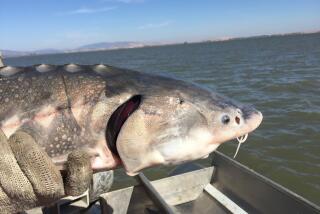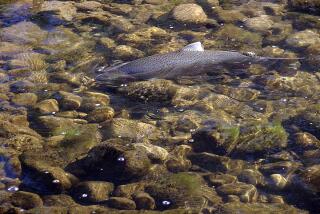Giant Catfish Vanishing From the Mighty Mekong River
- Share via
PHNOM PENH, Cambodia — Zeb Hogan plunges into the muddy brown waters of the Tonle Sap River and grabs hold of a 321-pound silvery giant catfish that has just slid out of a blue tarp held by several Cambodian fisherman.
“I take him by his mouth because I can hold onto him, but it doesn’t hurt him,” said Hogan, a researcher tracking the species, one of the world’s largest, that are only found here. Its vital signs are good: “He’s breathing, he’s fighting ... He’s trying to get away, now he’s shaking me and biting my finger.”
The Mekong giant catfish -- whose Cambodian name means “the king of fish” -- is a rare find in these waters, a Mekong River tributary. Its sharp fall in numbers -- only eight were reported caught last year, down from 80 a decade ago -- led to its listing as critically endangered and has researchers concerned about the health of the mighty Mekong.
“Here we have a species that runs a risk of being the first species in the Mekong River to go extinct,” said Hogan, a researcher at UC Davis.
Hogan has spent three years in Cambodia tracking the giant catfish. Fishermen alert him when one glides into their more than 328-foot-long nets trawling the river bottom, and Hogan goes out to weigh, measure and tag the catfish; collect a tissue sample; and release the animal.
His goal is to see how many of these catfish are left. They were once found in Laos, Cambodia, Thailand, Vietnam and perhaps Myanmar and southwest China. But today, fishing, dam building and navigation projects seem to have reduced their home waters to the Mekong, which flows through the heart of Southeast Asia, and its tributaries in Cambodia, Laos and Thailand.
When the catfish was listed as endangered on the World Conservation Union’s Red List of Threatened Species in 1996, not much was known about its rate of decline, said Caroline Pollock, a research scientist for the Gland, a Switzerland-based organization.
More data, including Hogan’s, have shown that its numbers fell by at least 80% over the last 13 years, a “pretty massive decline” that prompted the critically endangered classification in the group’s latest list released Nov. 18, Pollock said.
The giant catfish isn’t the average bottom feeder: It grows up to 660 pounds and nearly 10 feet in length -- sharing the title of largest freshwater fish with a close relative, the dog-eating catfish, according to the Guinness Book of Records.
Catfish in the United States don’t get much larger than 6 feet.
The fish is well-known in Mekong countries, where some people believe fishing for it has gone on for thousands of years.
In Cambodia, Buddhists pour a medicinal perfume on it to bring good luck. In Laos, legend has it that four centuries ago, the king used to sacrifice a man and woman each year to cave spirits to get their permission to catch the giant catfish.
And in Thailand, where the giant catfish has been proposed as the national fish, there’s a painting of it more than 3,500 years old on a riverbank cliff in the northeast.
Around the Mun River in northeastern Thailand, fishermen believe they must not catch it, and if they do, they hold a ceremony with a monk and burn a picture of it to ward off bad luck. In Baan Haad Bai on Thailand’s border with Laos, fishermen pray every April to the spirit that protects the giant catfish so they can catch it.
Fish are an important source of food and income for the more than 60 million people who live in the Mekong River basin. Studies show that the annual fishery yield is as much as 1.93 million tons, which is worth about $1.45 billion, according to the Mekong River Commission.
Men, women and children can be spotted fishing in Cambodia’s Tonle Sap River.
Some researchers believe that the fate of this legendary fish is a sign of things to come for other denizens of the 3,032-mile Mekong River, home to about 1,245 species, second only to the Amazon in terms of the biodiversity of its inland waterways.
If it goes extinct, “there’s something probably going on in the environment that’s not healthy for fish,” said Hogan, whose work includes genetics and migration patterns. “In all likelihood there’ll be other species that might disappear later.”
The river had mostly remained isolated because of wars and geography, but dams recently built along it in China and work on the upper Mekong River to clear channels for large boats are threatening the catfish and other species, said Chainarong Sretthachau, director of the Southeast Asia Rivers Network.
One Chinese dam is about 124 miles upstream from Khon Phi Laung, and proponents of expanded commercial navigation have suggested blasting the rapids area to enlarge the river -- a move researchers say could drive the giant catfish out of the water and into the history books.
More to Read
Sign up for Essential California
The most important California stories and recommendations in your inbox every morning.
You may occasionally receive promotional content from the Los Angeles Times.













